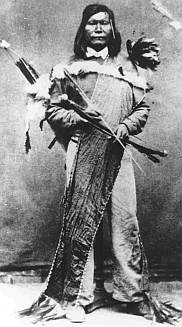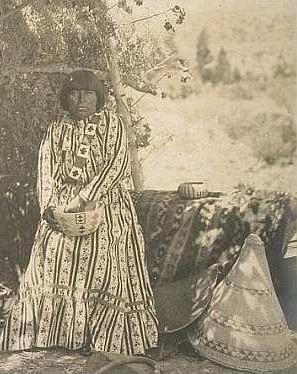Related Research Articles

The Arapaho are a Native American people historically living on the plains of Colorado and Wyoming. They were close allies of the Cheyenne tribe and loosely aligned with the Lakota and Dakota.

Sarah Hopkins was a Northern Paiute writer, activist, lecturer, teacher, and school organizer. Her Northern Paiute name was Thocmentony, also spelled Tocmetone, which translates as "Shell Flower."
The Shoshone or Shoshoni are a Native American tribe with four large cultural/linguistic divisions:

The Mono are a Native American people who traditionally live in the central Sierra Nevada, the Eastern Sierra, the Mono Basin, and adjacent areas of the Great Basin. They are often grouped under the historical label "Paiute" together with the Northern Paiute and Southern Paiute – but these three groups, although related within the Numic group of Uto-Aztecan languages, do not form a single, unique, unified group of Great Basin tribes.

Bloody Knife was an American Indian who served as a scout and guide for the U.S. 7th Cavalry Regiment. He was the favorite scout of Lieutenant Colonel George Armstrong Custer and has been called "perhaps the most famous Native American scout to serve the U.S. Army."

Mono is a Native American language of the Numic group of Uto-Aztecan languages, the ancestral language of the Mono people. Mono consists of two dialects, Eastern and Western. The name "Monachi" is commonly used in reference to Western Mono and "Owens Valley Paiute" in reference to Eastern Mono. In 1925, Alfred Kroeber estimated that Mono had 3,000 to 4,000 speakers. As of 1994, only 37 elderly people spoke Mono as their first language. It is classified as critically endangered by UNESCO. It is spoken in the southern Sierra Nevada, the Mono Basin, and the Owens Valley of central-eastern California. Mono is most closely related to Northern Paiute; these two are classified as the Western group of the Numic branch of the Uto-Aztecan language family.

The Paiute War, also known as the Pyramid Lake War, Washoe Indian War and the Pah Ute War, was an armed conflict between Northern Paiutes allied with the Shoshone and the Bannock against settlers from the United States, supported by military forces. It took place in May 1860 in the vicinity of Pyramid Lake in the Utah Territory, now in the northwest corner of present-day Nevada. The war was preceded by a series of increasingly violent incidents, culminating in two pitched battles in which 79 Whites and 25 Indigenous people were killed. Smaller raids and skirmishes continued until a cease-fire was agreed to in August 1860; there was no treaty.

Northern Paiute, endonym Numu, also known as Paviotso, is a Western Numic language of the Uto-Aztecan family, which according to Marianne Mithun had around 500 fluent speakers in 1994. It is closely related to the Mono language.

The Apache Scouts were part of the United States Army Indian Scouts. Most of their service was during the Apache Wars, between 1849 and 1886, though the last scout retired in 1947. The Apache scouts were the eyes and ears of the United States military and sometimes the cultural translators for the various Apache bands and the Americans. Apache scouts also served in the Navajo War, the Yavapai War, the Mexican Border War and they saw stateside duty during World War II. There has been a great deal written about Apache scouts, both as part of United States Army reports from the field and more colorful accounts written after the events by non-Apaches in newspapers and books. Men such as Al Sieber and Tom Horn were sometimes the commanding officers of small groups of Apache Scouts. As was the custom in the United States military, scouts were generally enlisted with Anglo nicknames or single names. Many Apache Scouts received citations for bravery.
Egan is the American name given to Pony Blanket. Pony Blanket was a Northern Paiute leader in the Oregon Country in the 19th century.
The First Battle of Pyramid Lake in 1860 was one of the opening conflicts of the Paiute War in Nevada between the American people and the Paiute people, who had resisted the increasing numbers of migrants who traveled the California Trail through their territory, taking scarce game and water resources, as well as altercations with the Pony Express.

Fort Harney was a United States Army outpost in eastern Oregon named in honor of Brigadier General William S. Harney. Fort Harney was used as a supply depot and administrative headquarters from 1867 to 1880 during the Army's campaign against Northern Paiute bands in Eastern Oregon and the Bannock uprising in the same area. Today, nothing remains of Fort Harney except a small cemetery.

Chief Paulina or Pahninee was a Northern Paiute war leader noted for his successful guerrilla tactics. He is known to have been active from 1859 until his death in 1867.
Billy Chinook was a chief and member of the Wasco tribe. Chinook was a guide for John C. Frémont and Kit Carson, who explored Central Oregon from 1843 to 1844 and from 1845 to 1847. Chinook also served as First Sergeant, U.S. Army Wasco Scouts during the Snake War. Lake Billy Chinook in Oregon is named in his honor.
The Utu Utu Gwaitu Paiute Tribe of the Benton Paiute Reservation, also known as the Benton Paiute Tribe, is a federally recognized Great Basin tribe in Mono County, California.

The Kucadɨkadɨ are a band of Eastern Mono Northern Paiute people who live near Mono Lake in Mono County, California. They are the southernmost band of Northern Paiute.
Catherine "Kay" S. Fowler is an anthropologist whose work has focused on preserving the cultures of the native people of the Great Basin. She earned her PhD from the University of Pittsburgh, and from 1964 to 2007 taught at the University of Nevada, Reno, where she is now Professor Emerita.
The Cedarville Rancheria is a federally recognized tribe of Northern Paiute people in Modoc County, California, about 30 miles (48 km) south of the Oregon border. Cedarville Rancheria is 26 acres in Cedarville. The tribal headquarters is located 20 miles away from the Rancheria in Alturas. The tribe has an environmental protection agency that is dedicated to keeping the Rancheria clean and teaching children how to protect and care for the planet.

Numaga was a Paiute leader during the Paiute War of 1860 that centered on Pyramid Lake in what is now Nevada in the United States. The war was caused by an influx of miners and ranchers after silver was discovered in the Comstock Lode near to Carson City. The newcomers assaulted the Paiutes and destroyed their foods supplies. When the Paiutes responded, the U.S. Army used force to suppress them. Both before and after the war, Numaga was a strong advocate of peace and did much to reduce the violence on both sides. He died of tuberculosis, a "white man's disease", in 1871.
Wuzzie Dick George was a Northern Paiute craftsperson who worked to preserve the traditional lifeways and tribal customs of her people. She served as a key collaborator in anthropologist's Margaret Wheat's efforts to record Northern Paiute lifeways.
References
- Braly, David. Crooked River Country: Wranglers, Rogues, and Barons. Pullman, Washington: Washington State University Press, 2007. ISBN 978-0-87422-293-7.
- Fowler, Catherine S. and Liljeblad, Sven. "Northern Paiute." Handbook of North American Indians: Great Basin, Volume 11. Washington, DC: Smithsonian Institution, 1986. ISBN 978-0-16-004581-3.
- Nelson, Kurt R. Fighting for Paradise: A Military History of the Pacific Northwest. Yardley, PA: Westholme Publishing, 2007. ISBN 978-1-59416-045-5